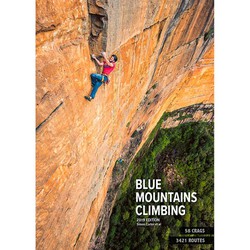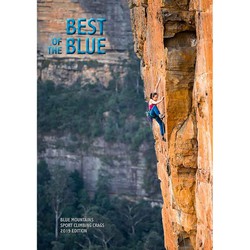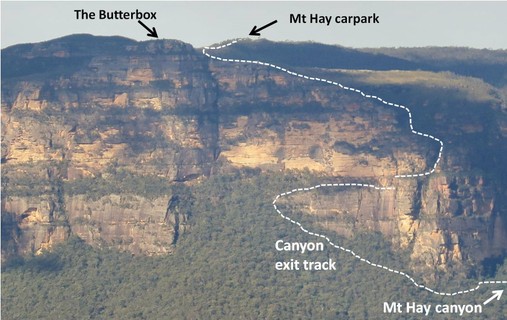
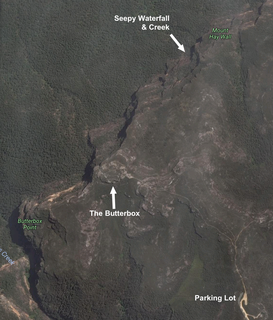
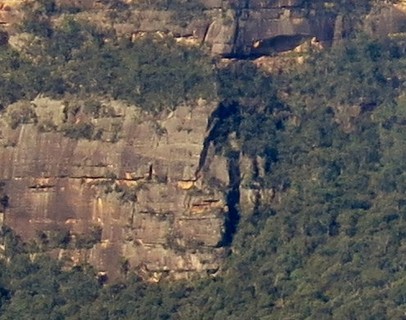
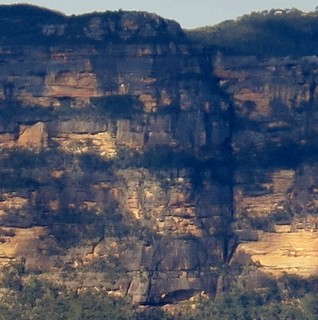
Beschreibung
A long, adventurous route up a prominent line. Some good exposure and excellent long pitches. Rock is of mixed quality, but bad sections can be avoided. Several pitches are broken up by 50m hikes up steep, loose, vegetated sections which can be quite taxing when added to the length of the climb. Rope drag can be a problem on some of the long pitches, and can be mitigated with twin ropes of at least 60m in length (but be careful of rope tangling during the hikes). Be sure to bring at least a full rack of Cams up to #5 (possibly doubles up to #3), wires, plenty of slings, and optionally a set of hexes (good placements on last pitch). Helmets are a must against loose rock/vegetation, and headlamps are recommended. Starting from the 8th pitch there are a few carrot bolts (slightly off-route) so bring a few bolt plates in case you want to use them.
13m (13) Marked start of the climb. A tricky and rather poorly protected traverse left leads to a large cave (good gear to protect second), walk left past a loose block to a belay out on the arete.
35m (9) A long and pleasant pitch up the nice tortoise shell wall above, getting easier with height. Wire and cam belay.
42m (11) Step up on top of the large flat block, place some gear at the back of the scoops, then step right to steep and juggy moves. These lead up for about 8m to a bushy ledge. Walk left along this, slightly down around the arete and left for approximately 30 metres across an easy wall to a tree below a crack through the bulge. Tree belay. Rope drag on this pitch is a serious concern.
55m (9) A really enjoyable and surprisingly long pitch. Head up the crack for a couple of metres then step out onto the right face. A long and juggy wall awaits, with a variety of gear. Tree belay on the halfway ledge. Follow the track up or 40m to the start of the upper cliffline.
58m (9) Start on the juggy face just to the right of the short right facing offwidth corner crack in the block. Another long, juggy and really enjoyable slab, with some good exposure up higher and well spaced but adequate protection. Go up for about 15m, left and up onto next slab, right at the top to avoid steep bit. Rope drag this pitch is a serious issue. Can be mitigated with double ropes. Walk up to next cliff.
55m (13) An excellent pitch and one of the hardest on the route. Up the lovely corner above, then up two lovely little 5m finger size layback cracks above that. Tree belay.
35m (13) Climb the initially vegetated, but nice corner up to the big roof, then traverse left to the arete. Straight up this, using the face on either side when it blanks out (take care of the hollow flakes on the right of the arete). A #5 Camalot is highly recommended for this section. Continue up to small tree and mid size cam belay. Walk 25m right to the obvious chossy chimney and a poor belay off a small tree.
30m (8) Up the chossy and unpleasant chimney for 8m or so (some pro in crack in left wall), then traverse out right on the easy ledge to big exposure being careful to avoid the flakes and weakened rock. Up the short wall to the next ledge, then crawl back left to the belay cave. Ridiculous rope drag is inevitable on this pitch, but can be mitigated with double ropes. Very poor belay off a single small thread in choss at the back of the cave. The second should exercise extreme care on this pitch, since a fall could blow the belay. There is good gear 1m higher on the left wall of the crack to beef up the belay. NOTE: There is a bomber thread inside the cave that goes from the bottom right (facing in) up the back to the outside of the cliff, a 120cm, thin (Dyneema) sling is required to reach and fit through the little hole. a poking stick helps too.
30m (6) Step left onto the easy wall, place a #4.5 or #5 Camalot just above the roof then easily up a dirty groove to the final ledge. A single carrot bolt sits at the bottom of the off-width crack for belay. Walk 20m right to the end of the ledge and the base of the final pitch, twin rings for belay. NOTE: Pitches 8 and 9 can be linked by continuing straight up the wide corner above the chimney, instead of traversing right. This is a much better alternative, though a little runout.
30m (9) Step up and right onto a small ledge below a left leading groove. Delicate stemming up the groove leads to a banksia tree and a final small ledge. Good gear in lovely crack on right then step up and over final 8 foot wall to the top. Twin rings for belay. Walk right 30m until you meet Canyon exit track, and follow this back to the carpark.
Historie der Route
| 1996 | Erstbegehung: Hayden Brotchie, John Gray & Paul Davies |
|---|
Warnungen
| 4 Dec 2020 | Warnung Fels: Start of route affected by fires |
|---|
Position
- Breite/Länge: -33.62465, 150.39407
Einige Inhalte wurden unter folgender Lizenz bereitgestellt: © Australian Climbing Association Queensland (Creative Commons, Attribution, Share-Alike 2.5 AU)
Schwierigkeitsgrad-Referenzen
| 13 R,9 R,11 R,9 R,9 R,13 R,13 R,8 R,6 R,9 R | Schwierigkeitsgrad |
| 13 | ★Dave McGregor |
| 17 [16 - 18] ++ | grAId |
Ethik
Although sport climbing is well entrenched as the most popular form of Blueys climbing, mixed-climbing on gear and bolts has generally been the rule over the long term. Please try to use available natural gear where possible, and do not bolt cracks or potential trad climbs. If you do the bolts may be removed.
Because of the softness of Blue Mountains sandstone, bolting should only be done by those with a solid knowledge of glue-in equipping. A recent fatality serves as a reminder that this is not an area to experiment with bolting.
If you do need to top rope, please do it through your own gear as the wear on the anchors is both difficult and expensive to maintain.
At many Blue Mountains crags, the somewhat close spacing of routes and prolific horizontal featuring means that it is easy to envisage literally hundreds of trivial linkups. By all means climb these to your hearts content but, unless it is an exceptional case due to some significant objective merit, please generally refrain from writing up linkups. A proliferation of descriptions of trivial linkups would only clutter up the guide and add confusion and will generally not add value to your fellow climbers. (If you still can't resist, consider adding a brief note to the parent route description, rather than cluttering up the guide with a whole new route entry).
If you have benefited from climbing infrastructure in NSW, please consider making a donation towards maintenance costs. The Sydney Rockclimbing Club Rebolting Fund finances the replacement of old bolts on existing climbs and the maintenance of other hardware such as fixed ropes and anchors. The SRC purchases hardware, such as bolts and glue, and distributes them to volunteer rebolters across the state of New South Wales. For more information, including donation details, visit https://sydneyrockies.org.au/rebolting/
It would be appreciated if brushing of holds and minimisation/removal of tick marks becomes part of your climbing routine. Consider bringing a water squirt bottle and mop-up rag to better remove chalk. Only use soft (hair/nylon) bristled brushes, never steel brushes.
The removal of vegetation - both from the cliff bases and the climbs - is not seen as beneficial to aesthetics of the environment nor to our access to it.
Remember, to maintain access our best approach is to 'Respect Native Habitat, Tread Softly and Leave No Trace'. Do not cut flora and keep any tracks and infrastructure as minimal as possible or risk possible closures.
For the latest access related information, or to report something of concern, visit the Australian Climbing Association NSW Blue Mountains page at https://acansw.org.au/blue-mountains/
Saisonalität
Qualität
Gesamtqualität 62 aus 47 Bewertungen.
Schwierigkeit - 13
Basiert auf 1 Bewertungen.
Vorgeschlagener Grad
Basiert auf 1 Bewertungen.
Begehungsarten
Schlüsselworte in Bemerkungen
Selected Guidebooks mehr Verbergen
Autor(en): Simon Carter
Datum: 2019
ISBN: 9780958079082
The latest comprehensive, latest and greatest Blue Mountains Climbing Guide is here and it has more routes than you can poke a clip stick at! 3421 to be exact. You are not going to get bored.
Autor(en): Simon Carter
Datum: 2019
ISBN: 9780958079075
Simon Carter's "Best of the Blue" is the latest selected climbing guide book for the Blue Mountains and covers 1000 routes and 19 different climbing areas. For all the sport climbers out there, the travellers, or just anyone who doesn't want to lug around the big guide that's more than 3 times the size - cut out the riff-raff and get to the good stuff! This will pretty much cover everything you need!
Unterkünfte in der Nähe mehr Verbergen
Inhalt teilen
Erhalte einen detaillierten Einblick mit einer Zeitleiste, die zeigt
- Begehungen von Kletterern
- Diskussionen in der Community
- Aktualisierungen des Indexes durch unsere Benutzer
- und viele weitere Dinge.
Logge Dich ein, um die Zeitleiste zu sehen!

